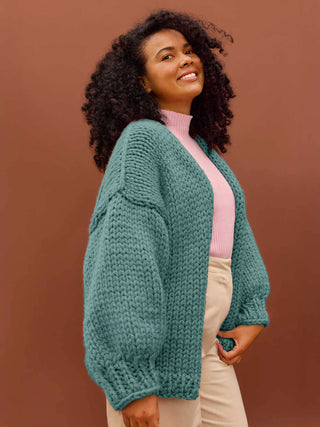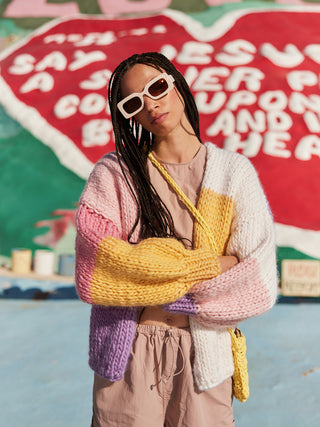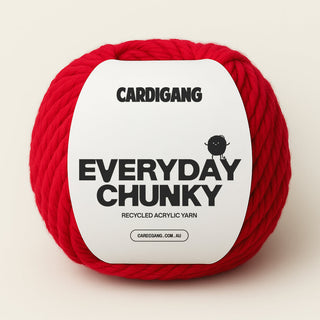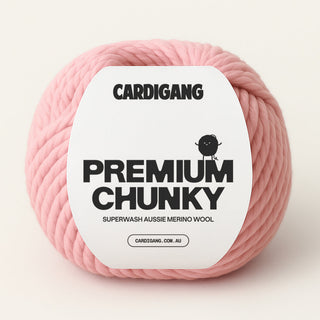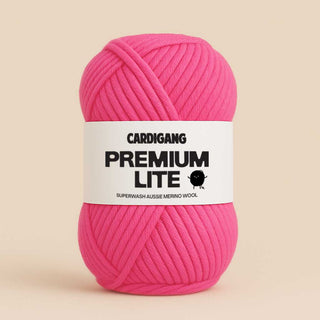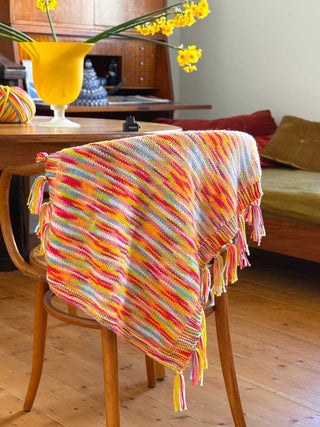A step-by-step guide to crocheting the cute-as-a-button Clyde Beanie
Ever gotten halfway through a project and thought “Hang on, am I even doing this right?” We have 🙋♀️
That’s why we’ve created these step-by-step guides to walk you through the process.
Even if you've never crocheted before, we'll take you from zero to hero in no time 🦸♀️
When it comes to crochet, practice makes perfect
Before we start the pattern, we suggest you spend some time learning the basic techniques you’ll need to complete your masterpiece 🤓
The Clyde Beanie is a dream to whip up and the perfect beginner project. She's made using just one (yes one!) stitch type - the half double crochet stitch. You'll want to be confident with this stitch before we start. You'll also want to get a hang of tying a slip knot and chaining which is the first step in any crochet project.
You can use the yarn that came in your kit to practice with. Once you've got these mastered you'll fly through your beanie.
Total beginner? 👩🏫
For a more comprehensive lesson on the basics of crochet visit our Learn to Crochet page.
🥣 Test your tension
While we're practising and before you start your project, you'll want to make sure your tension (how tightly or loosely your crocheting is) is juuuust right 🥣 We do this by making a “tension swatch”. It's a bit like Goldilocks, if the tension is too tight, your piece will be too small, and if it's too loose it may not hold its shape and might be too big.
Gauge: If done correctly, your 10x10cm swatch should be 9 stitches wide and 3.5 rows high when made in half double crochet on a 10mm hook.
To test this, chain on 12 + 2 stitches (the +2 makes your turning chain), then work in half double crochet for 5 rows. Then measure a 10x10cm square and count your stitches and rows within that space to make sure you're crocheting at the correct tension.
If you've got more stitches or rows than the instructions say you should have, your work is a little too tight, and if you've got less your work is too loose. Adjust your tension by holding the yarn a little more tightly/loosely as you crochet.
Onto the beanie, babe!

⚡️What you'll need
Your kit comes with everything you'll need to make your masterpiece. In your kit you'll find;
- 10mm hook
- 1 x ball of Cardigang Chunky Merino Wool
- A darning needle
- Made by me tag
You also want to have a pair of scissors handy.
🧶 Let's do this, happy hooker!
Time to whip up your warm-as-toast beanie.
Remember learning a new skill can be a little challenging at first, and you’re bound to find yourself making some mistakes along the way. But as with learning anything, your brain and your hands slowly start to get the hang of it, muscle memory is created, and soon the thing you found tricky/daunting/scary is like second nature! 💪
If you need a reminder of the techniques, just head back up the page and watch the videos again.
STEP 1
We crochet our beanie flat in a big rectangle which we sew together at the end. This makes Clyde perfect for beginners!
So to start, chain on your foundation chain of 27 stitches.
💭 Try to make your chain stitches as evenly sized as possible. Don't pull the loops too tight because you'll struggle to work into these loops in your first row. On the other hand, if you make your loops too loose, your project will look a little messy.
Once you've chained, you'll move onto the first row of half double crochet stitch.
STEP 2
Insert your hook into the 3rd stitch from the hook- this is the first and only time we'll insert our hook into the 3rd stitch from the hook. For the rest of the rows we'll work into every stitch.
Complete one row of half double crochet stitches.
STEP 3
This new row, row 2, is the row you'll then repeat for the rest of the beanie.
First, we create a turning chain. This turning chain builds the height we need to compete the row. Then we will do a half-double crochet into every stitch in your row.
💡 We're working just into the back loop. By doing this we create the 'rib' effect in our work. You'll need to make sure that you're putting your hook into the back loop of your stitches and not under both loops (bars) of the stitch.
STEP 4
Repeat for another 15 rows working into every stitch in the row.
STEP 5-7
Yes legend, you've (almost) made a beanie! 🕺
At this point, you'll have a lovely long rectangle. Time to seam your beanie together.
Fold your work in half so that the first row is laying on top of your last row.
We’re going to join our two seams by slip stitching the two ends together. To do this, insert your hook into the starting chain on your top piece, and then into the back loop of the next stitch on the bottom piece. Yarn over and slip stitch by pulling the yarn through both loops.
Continue to slip stitch both ends together along the row, making sure to work the slip stitches loosely and not too tight so that the hat remains stretchy. This will now become the inside of your beanie.
🎬 Watch How to horizontal seam
At the end of the row, cut your yarn, leaving a long tail for cinching the top and then fasten off.
STEP 8
Now that that you’ve made a tube it’s time to cinch in the top to make the beanie shape. Thread your darning needle with the tail of yarn you’ve left from the previous step and thread a running stitch around the edges of the tube to gather the top. Pull your yarn tight to close the loop and tie a knot to secure it.
There'll still be a small hole at the top, so continue to close up the hole with your darning needle. When done, knot the yarn again and then weave in all the ends. Turn your hat inside out.
D.O.N.E! You've finished your beanie, well done! Epic work 🤩 If this was your first-ever crochet project or one of many, we hope you had a blast making your masterpiece 💥❤️
In a bind and need a little more help?
Email us at stitchup@cardigang.com.au and we'll be able to help! Whether you're just starting out, or you've got a specific question or problem (dropped a stitch, no stress!), we're here to get you out of a bind.



